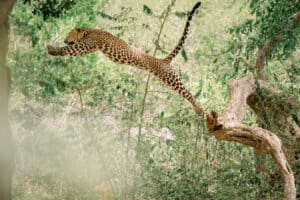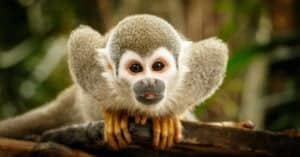There are over 260 different species of monkeys in the world, and they are man’s closest living relatives in the animal kingdom. Many monkeys live their lives in trees. However, there are some exceptions, like baboons who prefer the ground. Interestingly, the smallest monkey is the Pygmy Marmoset and the largest is the Mandrill. Additionally, all monkeys have tails. However, some are smaller and look like stumps. Monkeys eat various food, but the most common are seeds, fruits, eggs, small insects, leaves, and flowers. Depending on gender, some kinds of monkeys have different skin colors. There are many species of monkeys with black coloring, but some are partly black. Here is a complete list of black monkeys and everything you need to know about them.
1. Agile Mangabey
This monkey forms part of the Old-World monkeys of the White-Eylid Mangabey group, which can be found in swampy forests. They can live up to 20 years in the wild. Also, Agile Mangabeys are social animals, so they will stay in troops and move together. Agile Mangabeys are some of the world’s most endangered and rare monkeys. Furthermore, they only occur in Africa and can be black, gray, or golden brown.
All mangabeys have tails that are longer than their bodies, which helps them balance as they jump from tree to tree. Young mangabeys are generally darker in color than adults. In addition, the black mangabeys have long grayish-brown whiskers and a high crest on the top of their head.
These monkeys communicate by using exciting sounds, as it can be hard to see each other in the dense forests where they live. They can be very noisy. They have a special throat sac that gives them a booming voice, and the males have larger sacs than the females. Additionally, they use a shrieking alarm call to alert others to danger. Furthermore, a male can make a whoop-gobble to warn others of where he is that can be heard up to 1,000 yards away.
Mangabeys have powerful jaws and teeth that assist them in cracking hard shells or nuts and biting into thick-skinned fruit. Also, they like to tear bark from trees to find bugs and spiders that hide underneath. They have a varied diet that can include:
- Fruit
- Nuts
- Insects
- Leaves
- Seeds
- Spiders

All mangabeys have tails that are longer than their bodies, which helps them balance as they jump from tree to tree.
Image: Mikhail Blajenov, Shutterstock
©Mikhail Blajenov/Shutterstock.com
2. Amazon Black Howler
These monkeys come from Brazil and live in the rainforests. They are herbivores and can grow up to 36 inches. Also, they have a stocky build, are quite large, have all-black faces, and are known for having a mighty howl. Additionally, they are one of the biggest primates in the Neotropics. Amazon black howler monkeys can reach a height of 22 to 36 inches when standing, and their tails can be as long as their bodies. They are all black monkeys and appear scary to some people. Lastly, they have prehensile tails that they use to grab branches when swinging from tree to tree.
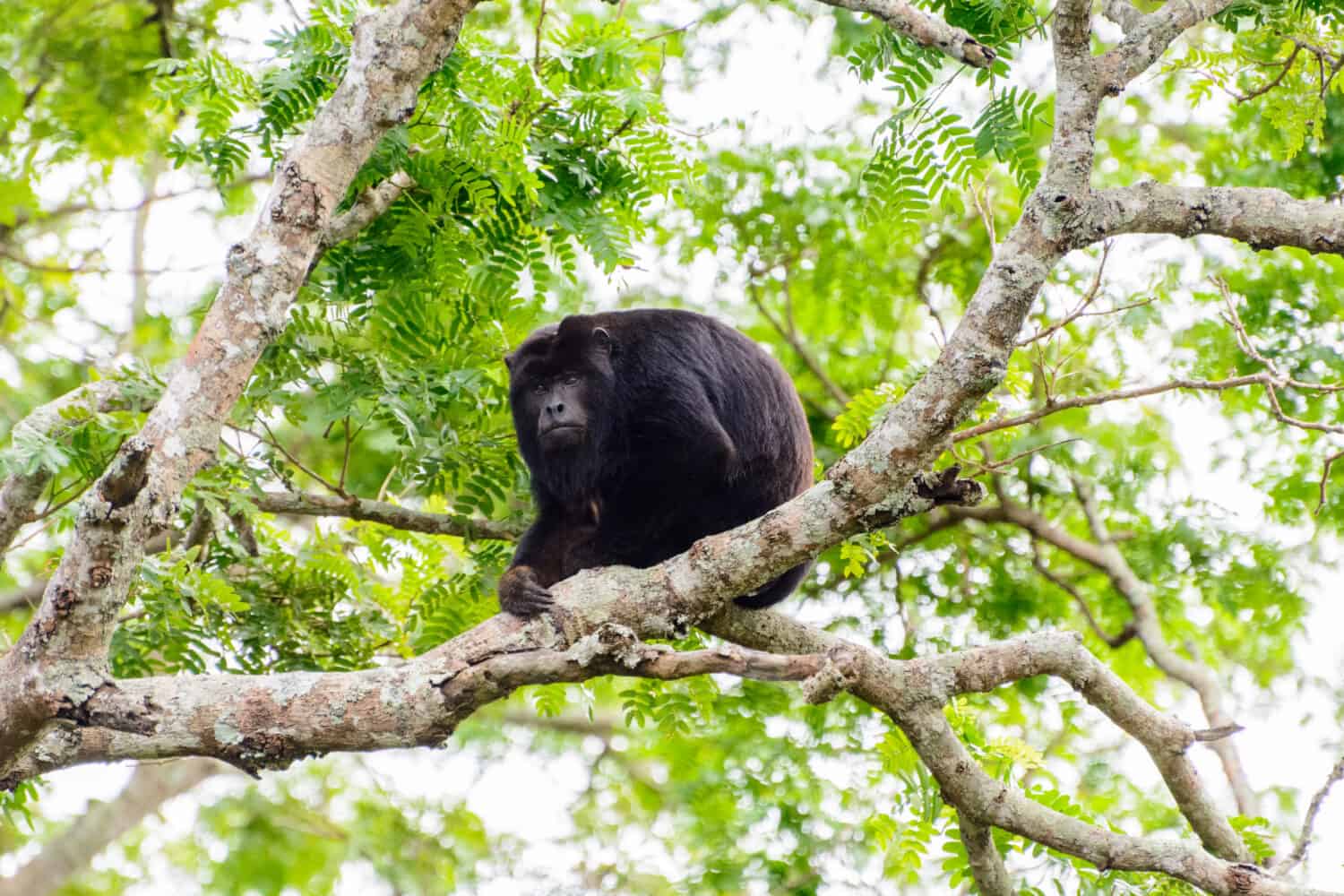
Amazon black howler monkeys can reach a height of 22 to 36 inches when standing, and their tails can be as long as their bodies.
Image: Lisa Stelzel, Shutterstock
©Lisa Stelzel/Shutterstock.com
3. Andean Saddle Tamarin
The Andean saddle tamarin is also sometimes known as the saddleback tamarin and is a New World monkey species. They occur in Ecuador, Peru, Brazil, Columbia, and Southeastern America from Bolivia. Additionally, they have dense dark fur which covers their torso, shoulders, and arms. These monkeys have a patch on their backs, including yellow and orange stripes with patches of black hair, where the “saddle” part of their name comes from.
Andean saddle tamarin’s monkeys have orange-yellow fur on their hindquarters and black fur tails. Furthermore, they have long, narrow hands that help them to reach into small spaces to catch insects. Lastly, these monkeys have scalloped ears on their small round heads, and some have white whiskers.

The Andean saddle tamarin is also sometimes known as the saddleback tamarin and is a New World monkey species.
©thibaudaronson / CC BY-SA 4.0 – License
4. Angolan Colobus
The Angolan colobus is mainly a black monkey, also known as an Angolan black or white colobus. They occur in eastern Africa, including Cameroon, Gabon, Uganda, Nigeria, Ethiopia, Tanzania, Kenya, the northern parts of Congo, and the northeastern parts of Zaire. Furthermore, they like to live in dense rainforests, lowlands, bamboo forests, and mountains. They prefer to live in troops, and these monkeys have no specific breeding season. A troop typically has one dominant male and two to six females.
Additionally, a female’s gestation period is about 147 to 178 days. When a female gives birth, they typically only have one baby, occasionally twins. Furthermore, when these monkeys are born, they are white, and their color changes when they are about three years old. Babies will stay with their mothers for about 15 months.
Angolan colobus monkeys are medium-sized and have long tails and thin bodies. Also, they are primarily black with contrasting white hair on their tails and shoulders. Their lifespan is between 20 to 30 years in the wild, and they eat things like bark, stems, shoots, leaves, and fruit. Lastly, they are not endangered but are threatened by things such as hunting, habitat loss, humans, eagles, and leopards.
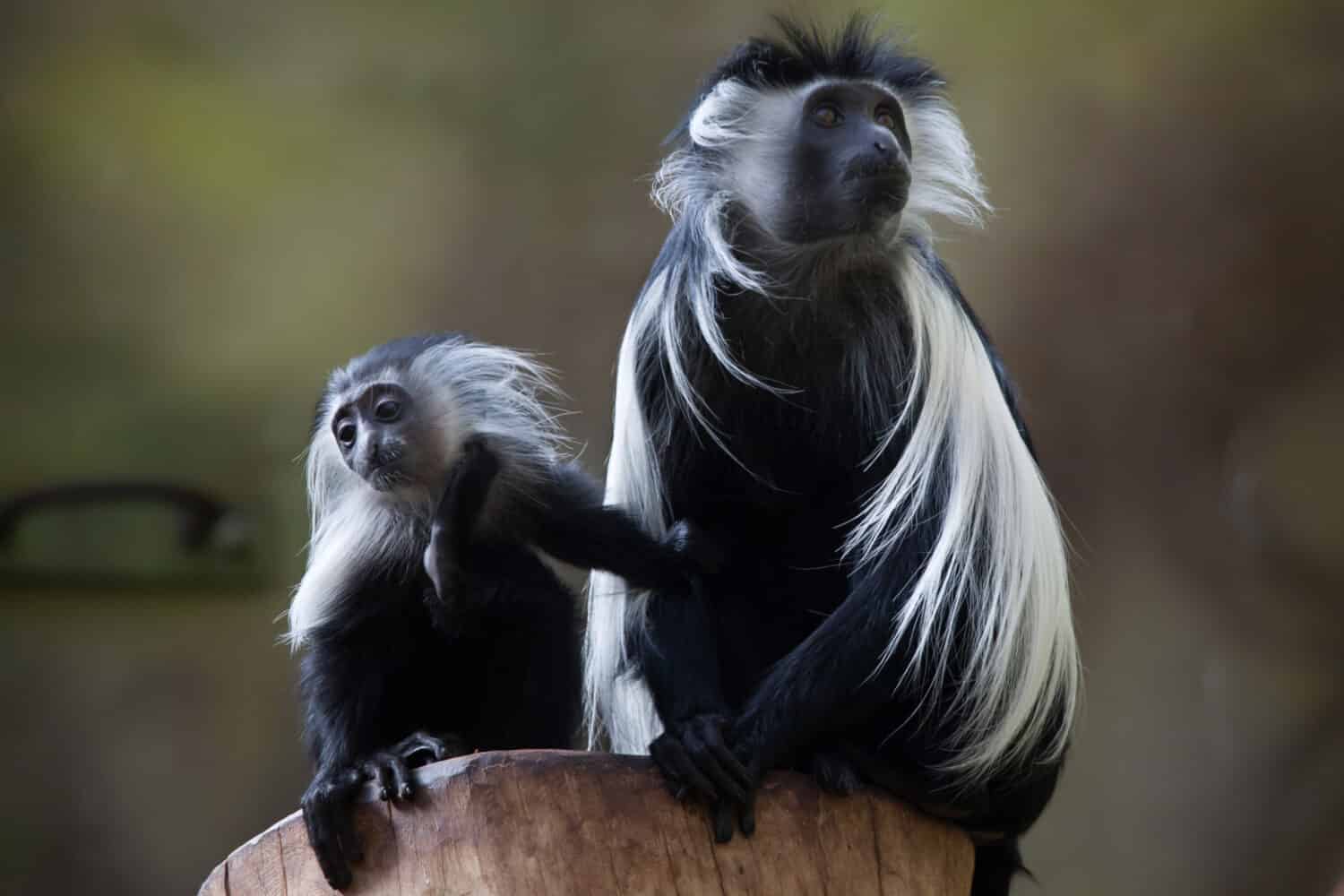
The Angolan colobus is mainly a black monkey, also known as an Angolan black or white colobus.
Image: Vladimir Wrangel, Shutterstock
©Vladimir Wrangel/Shutterstock.com
5. Robinson’s Banded Langur
A Robinson’s banded langur, also known as Robinson’s banded surili, is part of the Cercopithecide family. Also, they are similar to the Raffles banded langur. They are black with white fur on their bellies and a white stripe on the underside of their limbs. Furthermore, they have slender limbs and long tails. Lastly, the hair on the head of Robinson’s banded langurs stands on end in a triangle or Mohican formation.
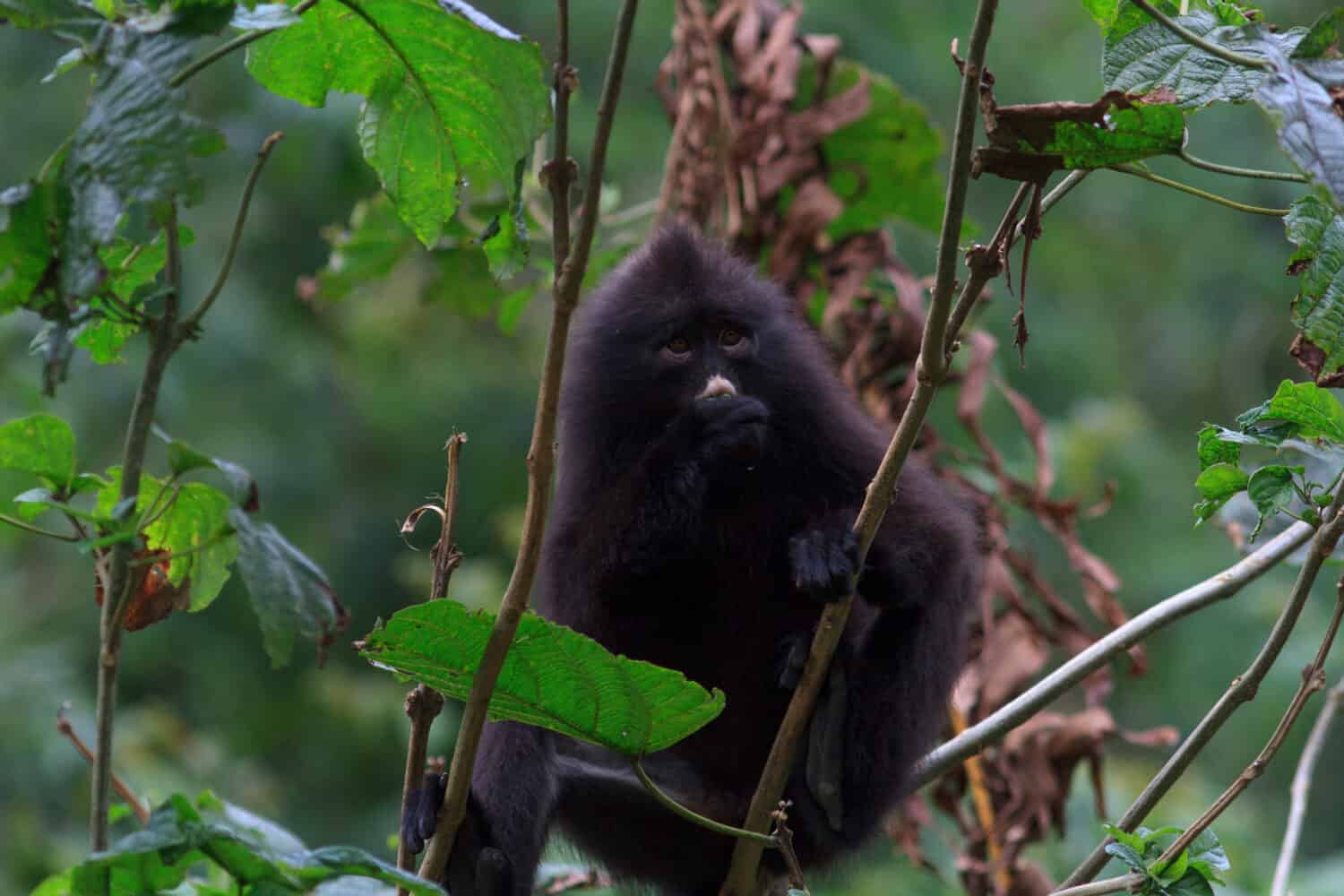
A Robinson’s banded langur, also known as Robinson’s banded surili, is part of the Cercopithecide family.
Image: Polbkt, Shutterstock
©Polbkt/Shutterstock.com
6. Black-Bearded Saki
One of the five remaining species of the New World monkey is the black-bearded saki. While these monkeys are black, some can be a brownish color. Furthermore, two rounded bulbs protruding from their foreheads distinguish females and males. Also, they have another striking feature, their signature beards. These monkeys have a lovely heart-shaped profile, and from a distance, it can be hard to identify their heads because of their bushy tails. Lastly, they have short front and longer back legs with not fully opposable thumbs, perfect for running through treetops.
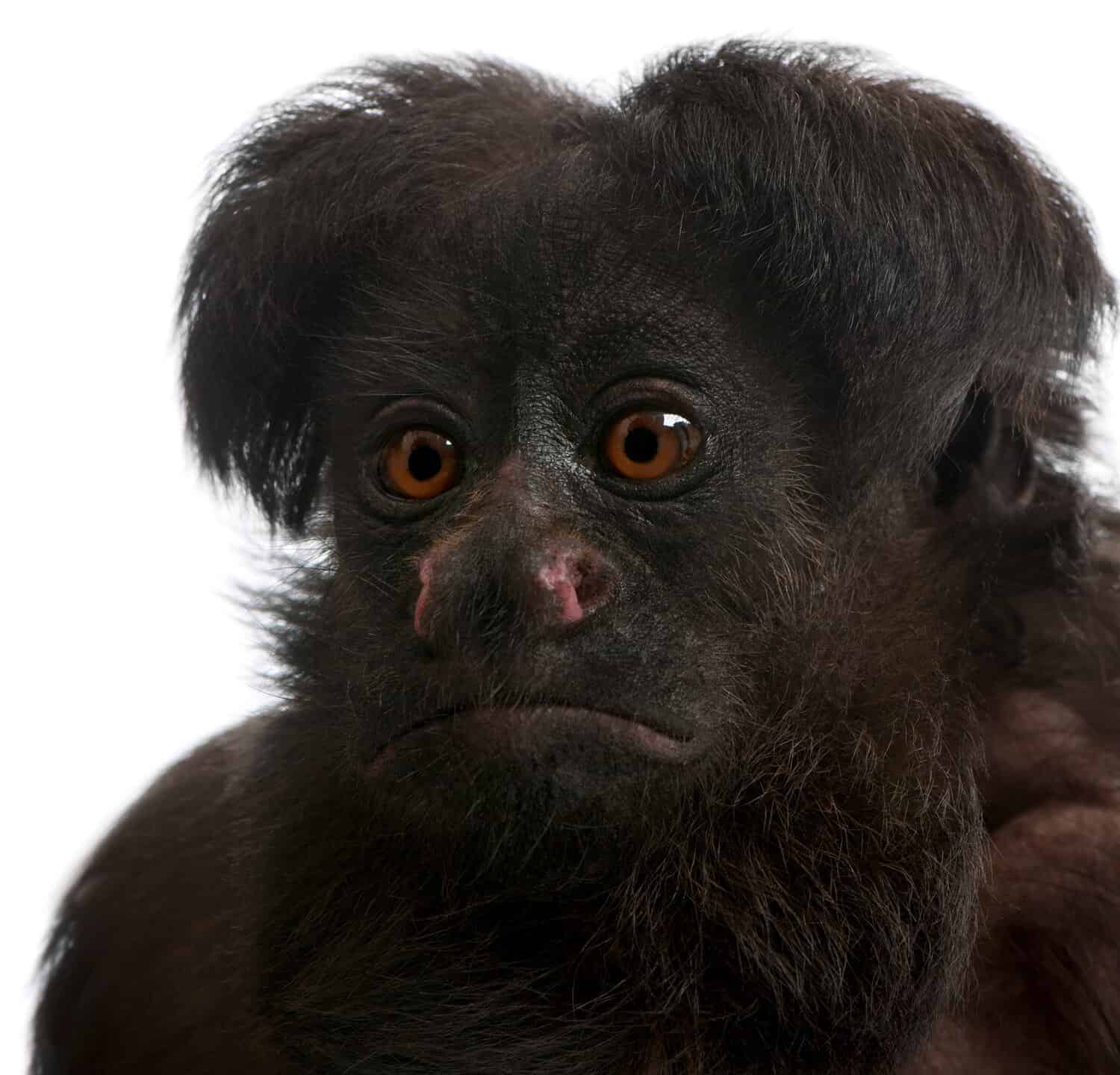
One of the five remaining species of the New World monkey is the black-bearded saki. While these monkeys are black, some can be a brownish color.
Image: Eric Isselee, Shutterstock
©Eric Isselee/Shutterstock.com
7. Black Capuchin
Capuchins are known as the brightest New World monkeys and are not an ordinary species. They are super clever and unique. Furthermore, they are funny, intelligent, and witty black monkeys. However, they can be lazy at times. They occur in the forests of South and Central America. Additionally, capuchins enjoy a long lifespan and can live up to 25 years in the wild and up to 35 years in captivity. They mainly eat fruit and nuts as well as some other small animals.

Capuchins are known as the brightest New World monkeys and are not an ordinary species. They are super clever and unique.
Image: guentermanaus, Shutterstock
©guentermanaus/Shutterstock.com
8. Black Spider Monkey
These large monkeys can move quickly through the trees from southern Mexico to Brazil. Spider monkeys weigh an average of 13 pounds and are about 14 to 26 inches, excluding their tails. Their tails are longer than their bodies, and they use them as a fifth limb to swing from trees and hold objects. Also, their coat varies in texture and length and can be black, dark brown, or gray to reddish. Most of these monkeys have black faces with white rings around their eyes. However, some have flesh-colored faces. Also, they live in troops of up to 35 and spend most of their time moving around the highest branches of trees during the day. Their diet includes nuts, fruit, flowers, leaves, and spider and bird eggs.
Spider monkeys produce various sounds, sometimes calling to each other in a whinnying voice like a horse if separated. Additionally, these monkeys are in danger of dying out because they are hunted for food, and the trees where they live are being cut down in some areas. Also, they sometimes catch diseases like malaria.
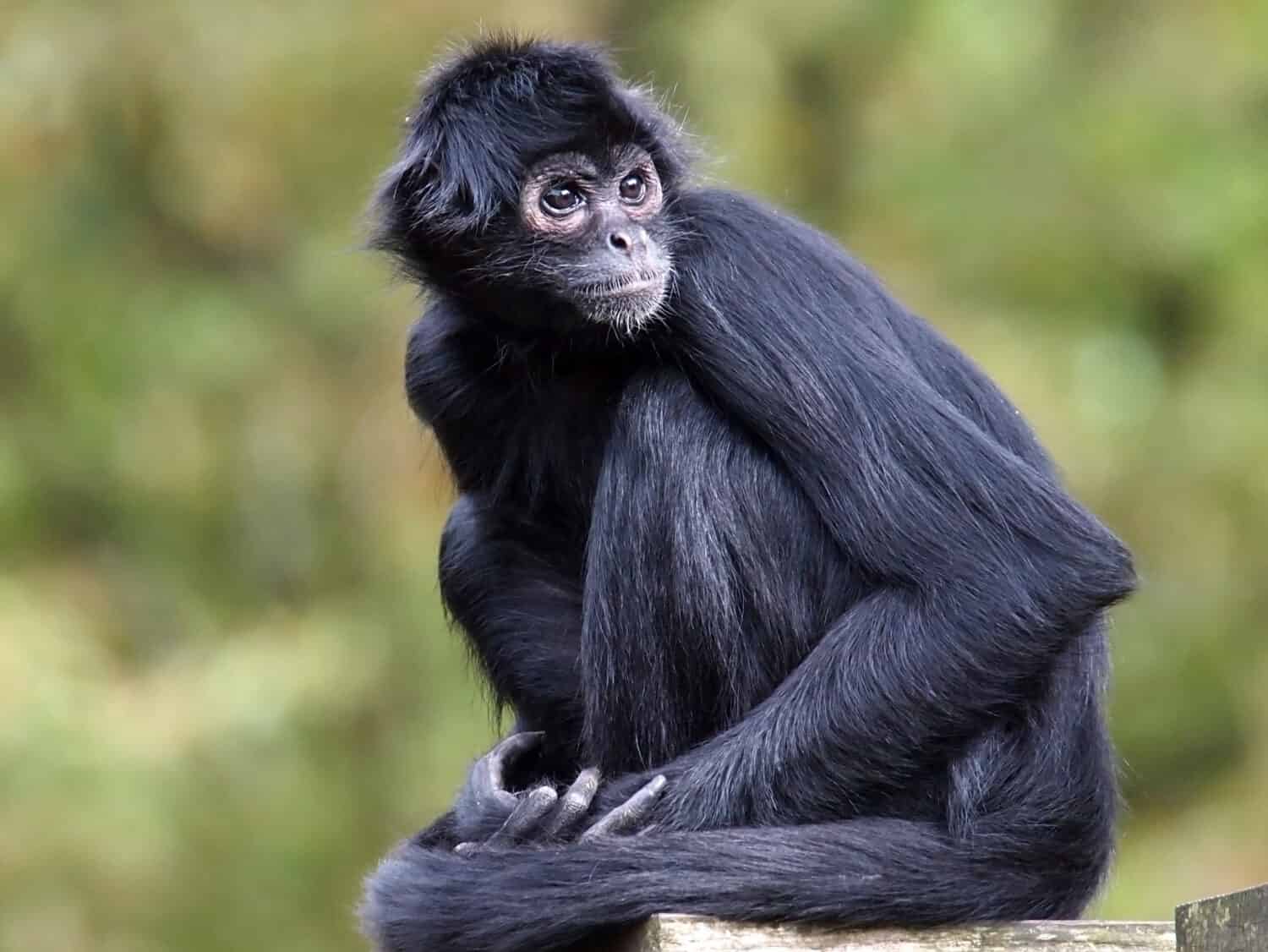
Spider monkeys weigh an average of 13 pounds and are about 14 to 26 inches, excluding their tails.
Image: Edwin Butter, Shutterstock
©Edwin Butter/Shutterstock.com
The photo featured at the top of this post is © David Havel/Shutterstock.com
Thank you for reading! Have some feedback for us? Contact the AZ Animals editorial team.




